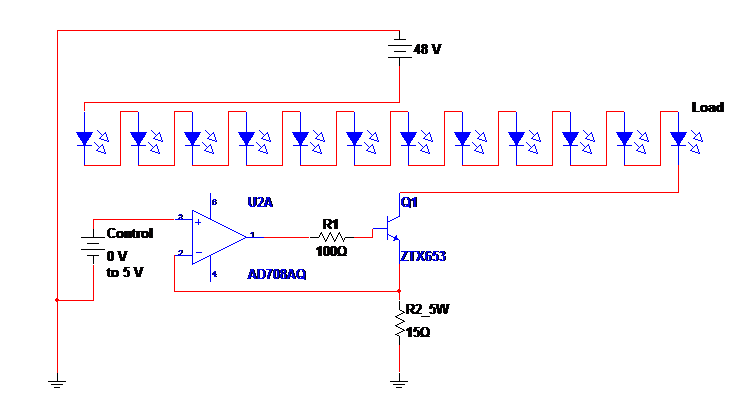We address an improvement on current control to modulate intensity of LEDs.
As of the 20th of November of 2012 the intensity of the LEDs for a specific Art Installation project was controlled with Pulse Width Modulation. Although working, given the characteristics of their use, they flicker when varying in intensity and frequency of activation.
We proposed a new intensity control by varying the current applied to the LEDs. Using this next circuit we accomplished that.

The LEDs have a drive current of up to 350mA, which corresponds to a voltage of around or above 40V. For the purpose of the installation, we have power supplies of 48V.
To create a voltage controlled current we use a NPN transistor and an Operation Amplifier. By using negative feedback on the amplifier, we regulate the voltage applied to the transistor so that the current amplification keeps a constant relationship of
Current at R2 = Vcontrol/R2
By applying giving this negative feedback to the amplifier, and given its gain, we get a small current going to the Base of the transistor, controlling the passing of current from the Base to the Emitter. As said this last current is given by the formula above.
The first Op-Amp we used was the LM358P, but later changed to the AD708JN, because we wanted to improve the input voltage offset. This offset might be the origin of an undesired behaviour we observed in the Oscilloscope.
When a very low voltage is applied with a square wave as control signal, we observe a type of noise that makes the light of the LEDs to flicker. This can be due to the input voltage offset.
Another idea is that the magnitude of the gain of the op-amp can cause that small differences on the feedback are amplified creating this oscillation of the output.
The selection of the Transistor has not yet been optimized, as the one we use now seems to have problems with heat, although it works well for the sake of the firsts tests.
hi..
can i control transistor with uc I/O pin…
what are the changes it need..
Indeed, the source here of 5 volts can be from a microcontroller, where you can vary the pwm to achieve a duty cycle that is equal to a voltage value between 0 and 5V or whichever amplitude you can achieve with the GPIO